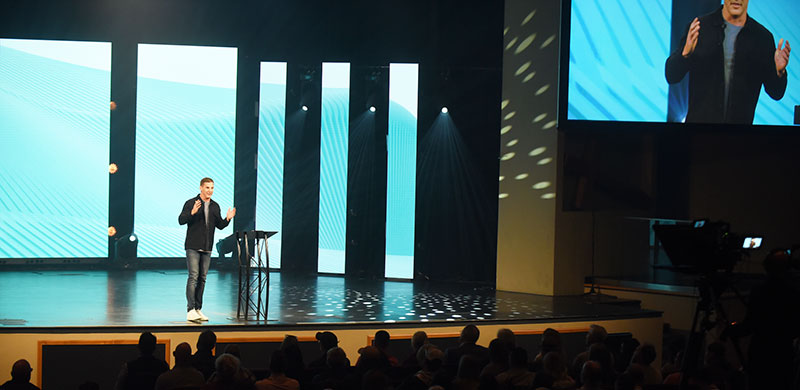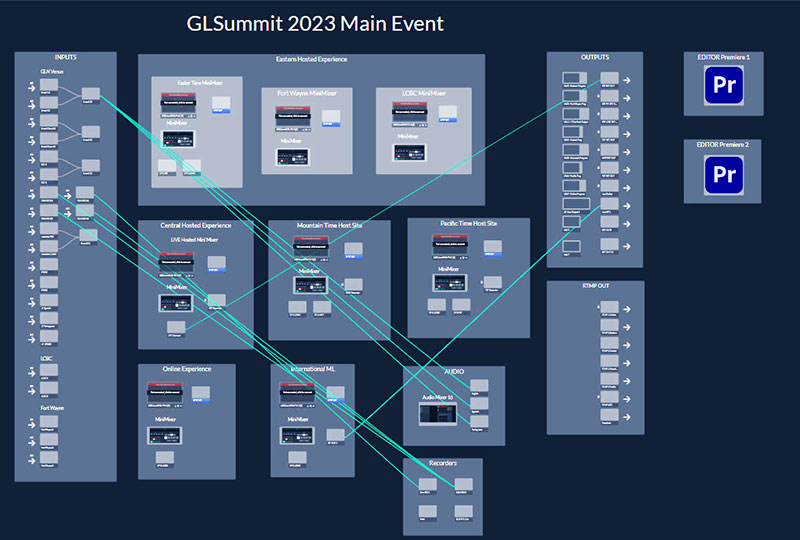Global Leadership Network uses GV AMPP to produce and deliver localised, time-shifted live streams to over 650 North American host venues, plus translated versions for overseas viewers.

The Global Leadership Summit (GLS) is an annual inspirational gathering held by the Global Leadership Network (GLN). This full two-day conference features recognised speakers who share insights and knowledge to motivate the next generation of leaders to address and solve such issues as social injustice and inequity, and serve as catalysts for positive change in the world.
For its Global Leadership Summit held in autumn 2023, GLN’s goal was to engage people in an immersive leadership experience comprised of eight hours of daily programming. The event featured speakers ranging from former US Secretary Condoleezza Rice and Intel Corporation CEO Pat Gelsinger, to author and Harvard Business School Professor Anita Elberse and Dallas Mavericks CEO and Author Cynt Marshall.
Full House
This event attracted more than 250,000 viewers worldwide, including 7,200 attendees at Willow Creek Church, a non-denominational Evangelical megachurch in South Barrington, Illinois that hosted the actual live event. Thousands also registered to watch and attend the event in person at over 650 local host venues across the United States and Canada, and thousands of other viewers joined from overseas via online streaming through GLS partner, Sardius Media.
To manage the complexity of running and distributing multiple localised feeds, the GLS decided to distribute the live event entirely from the cloud for the first time. Tools available on the Grass Valley AMPP Software-as-a-Service (SaaS) platform were used for video processing and playout.
As a cloud-native suite of software, AMPP orchestrates and integrates the capabilities involved in producing and distributing live and pre-recorded broadcasts and streams. Its functionality includes ingest, virtual switching, slo-mo, replays, CG, transcoding, recording and playout servers.
It also represents a very wide technical scope, and therefore AMPP was considered as possibly the only way to facilitate the event’s global streaming and distribution, cost-efficiently and entirely in the cloud. AMPP made it possible to build an end-to-end infrastructure, on demand from scratch. Through its agility and scalability, the production team was also able to modify its AMPP configuration to handle unexpected demands on the fly.
From Single Event to Multiple Streams
Rather than simply outputting a single live webstream of the main event and delivering it from Willow Creek Church to all destinations, GLN wanted to be able to produce and distribute relevant live conference material, customised to match the interests of those attending in person at each of the local host venues. To do that, a complex streaming workflow was designed to create up to 12 different concurrent live streams.
Each stream included the main conference content for all audience segments, plus fresh content personalised for the regional venues, and Spanish and Portuguese versions. The customised content web streams for the venues then needed to be delayed or time-shifted to account for differences between the venues’ four time zones – Eastern, Central, Mountain and Pacific Time. All the streams needed to be closed captioned as well.

Virtual Production control room
Advanced Systems Group (ASG) helped GLN and their Director of Broadcast Kyle Healy configure a Virtual Production control room based on AMPP (running on Google Cloud). The setup utilised several of AMPP’s integrated services, such as ingest, switching, transcoding and playout. It resulted in a reliable infrastructure of smoothly integrated systems.
Mobilising Dispersed Teams
Using AMPP’s user interface, the production crew very quickly learned to monitor and control all of their concurrent feeds. Its dashboard continuously displayed clear, legible workflow illustrations, multiviewer monitors and real-time status indicators. The GLN team was especially pleased with how they could simplify even very complicated, multifaceted tasks, making them straightforward for their front-end operators.
To ensure that the production went off without delays, ASG’s Director of Cloud Production Solutions and Engineering Jorge Dighero was present to give on-site technical support, while ASG supplied further technical support remotely.
Claudia Souza, ASG’s Chief Cloud Officer said, “An AMPP installation can be all cloud, all on- premises, or a hybrid of both. Grass Valley also makes different payment options available, such as pay-as-you-go or subscription-based billing, which helps customers control and manage their costs.”
“The question is no longer whether cloud-based live video production is possible or viable,” Claudia said. “The question now is about how customers can implement it most cost-effectively and advantageously for their application. With our AMPP expertise, combined with familiarity with GLN’s particular production goals and budget, we were able to give the organisation specific recommendations for the most cost-effective workflow options and strategy possible.”
More Choices, Greater Scale
With a conventional hardware-based approach, users pay for the capital investment. Meanwhile, these ownership costs persist even when the gear sits idle. Then, if additional resources are needed, such as another switcher or playout system, on-premises-based CAPEX costs rise further. Users must also factor in the cost and time delays associated with systems integration to bring the additional units into a seamless workflow.
In contrast, the costs associated with cloud hosting and processing only apply to times of actual use, and since processing is virtualised in a cloud environment, video functionality can be increased or scaled back in a few minutes. AMPP users can access any of the AMPP applications they need through Grass Valley’s App Store, downloading them onto the platform. They can also use AMPP-compliant third-party software and systems from various Grass Valley partners.
Kyle Healy recalled some of the limitations and restrictions of facility-based workflows for previous events GLN has streamed. “Compared to a mobile unit, which can only work with whatever equipment and capabilities are on the truck at the time it arrives on site, AMPP’s cloud ecosystem is more agile and scalable,” he said. “If I need more switcher capacity, playout and record channels or whatever, AMPP can be reconfigured on-the-fly to cover that need.
“With AMPP, rather than doing without or finding workarounds for missing functionality, we could immediately ramp up to build a full Virtual Production control room from scratch, and then dismantle it as soon as it was no longer needed. That ability to scale down or discontinue any part of the workflow was in some ways as important as adding functionality to address an unexpected need.” Altering the workflow was often just a matter of selecting new settings or pulldown menu options from the AMPP dashboard in a browser.

Time-shifting strategy
Stream Management
During the live event, the 1080i signals from the switchers at the main venue were converted to SRT signals, which were then delivered directly into the growing pool of video in AMPP’s cloud ingest server. Once in AMPP, the video was immediately available and accessible to the full production team, including authorised users working at remote sites. Streams for localised distribution could also be processed entirely in AMPP’s cloud-based switchers.
Since the primary stream originated at Willow Creek Church, which is in the Central time zone, the live streams needed to be delayed or time-shifted as mentioned above so that anyone at the host venues in Eastern, Mountain and Pacific Time zones would have a comparable viewing experience.
To do this, viewers were shown ancillary break-out content, which was shot at various host venue sites and customised for their region. This content helped to fill the breaks between presentations and allowed Eastern time zone viewers to catch up to the start of the Central time-hosted event. At the host venue sites, the break-out video content was recorded onto mini recorders, switched using mini mixers, output using clip players, and watched on separate multiviewers and AMPP flow monitors.
Content Capture and Creation
The camera crew also needed to record nine hours of programming every day for each of the regions. The high volume of recording that resulted was further increased by the ISO recording of signals from individual cameras at each host venue site. Since it was a live event and couldn’t be repeated, the recordings needed to be fail-safe as well.
Because the recordings were also key to creating the social media packages and featurettes distributed immediately following the live event, remote video editors had near-immediate access within 30 seconds to the growing video files. They were able to get straight to work on the material using Adobe Premiere, and could share and edit the media without disturbing the critical workflow designed for production of the main event.
In previous years, social media content creation was actually a complicated, time-consuming process that took three to four days to complete. It involved a massive data transfer via hard drives that were shipped and shuttled from place to place. Now, by working in AMPP’s cloud- based system, the editors can have the finished content ready for distribution only about two hours after the event closes.
Asset Management
The Summit editors could use Grass Valley’s Framelight X media asset management software, which runs on AMPP, to good advantage because it is made for globally distributed teams who need to collaborate and work through systems that adapt dynamically to demand. By federating content into a universal asset management system, Framelight X supports content sharing and avoids duplication.

Framelight X MAM software
The comprehensive nature of AMPP as a live production and streaming platform, instead of a single cloud-based application, means it has applications beyond production, processing and playout. At the GLN’s Summit, for example, it also helped identify and diagnose the source of a persistent lip sync issue that arose in the lead up to the live event.
Using data analysis and status monitoring within AMPP, ASG’s engineer Jorge Dighero was able to determine that the problem stemmed from encoders downstream of the AMPP workflow. Within a short time, he was able to use AMPP to launch RTMP encoders to replace them and resolve the lip sync issue.
RTMP encoding and streaming connect the encoder, streaming server and media player by breaking down video and audio data into smaller packets, using an RTMP encoder. As well as achieving low latency, RTMP also allows the user to adjust the audio format and the video and audio bitrate.
Multi-Destination Delivery
On final output, the live program streams were delivered to Sardius Media for distribution at 1080p59.95 to multiple destinations. This included stream versions for in-person, online and non-English speakers worldwide. Sardius Media specialises in live event streaming for customers in sectors like government, corporate and worship, and was familiar with this complex type of delivery.
In particular, international viewers could receive the live global feed with real-time foreign translations. Three different languages were embedded in the stream with two channels each: English, Spanish and Portuguese. This audio was dubbed and the A/B signals mixed into the live stream in a way that preserved the original speaker’s voice and ambience in the background.
Jorge commented that AMPP is one of the few cloud-native video production platforms capable of producing and delivering broadcast- quality live streams, and Kyle Healy also said, “AMPP’s agility and scalability resulted in significant operational and financial savings for the Summit. It also gave us extensive creative freedom during what proved to be a very technically complex and demanding live-streamed video event.” www.grassvalley.com




















